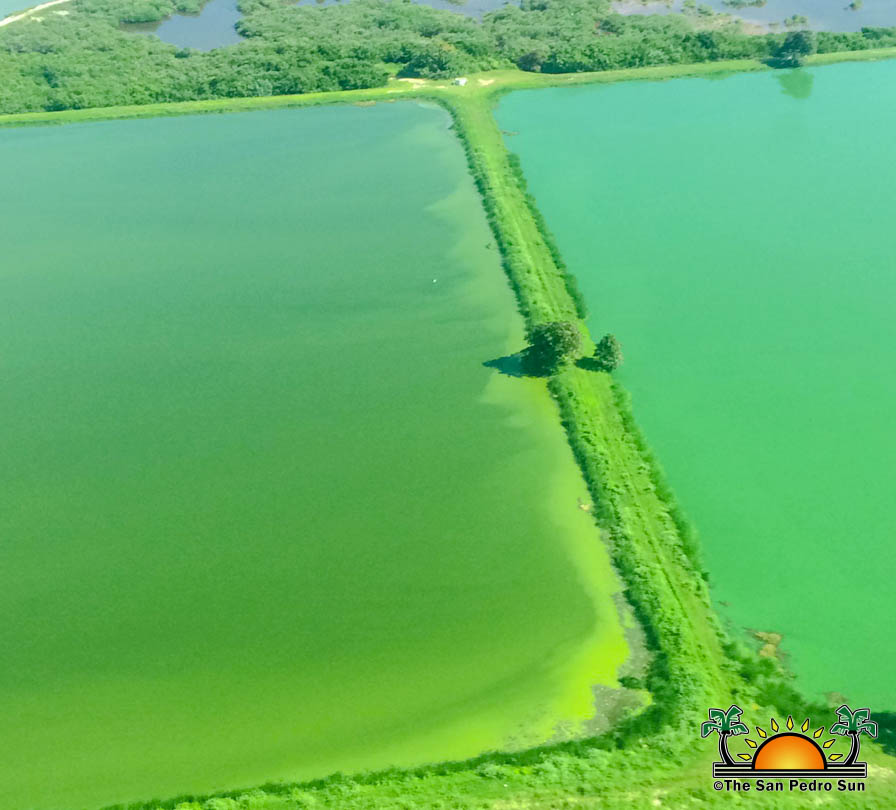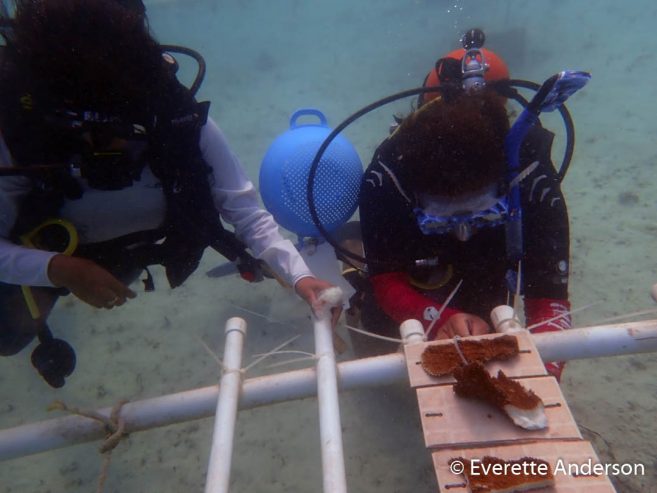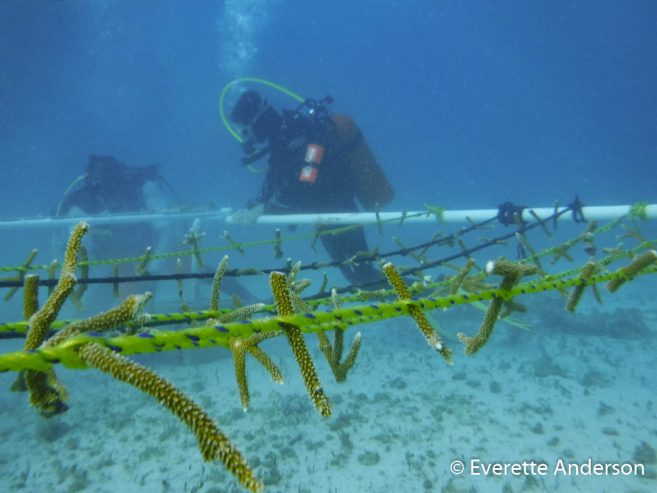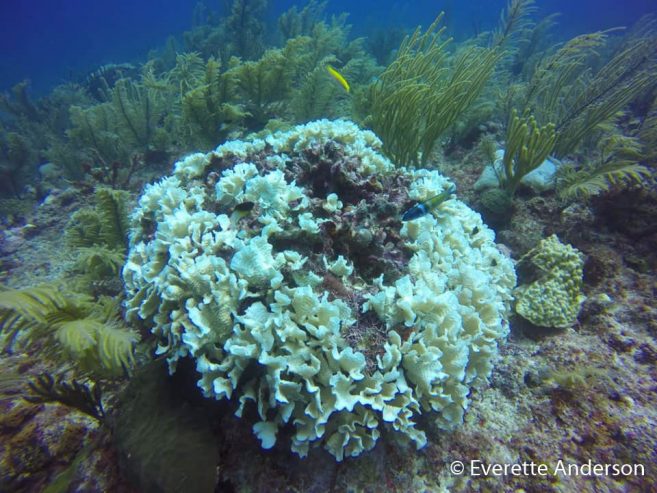Ambergris Caye off the north-eastern coast of Belize is the largest and most populous island in the country and considered the prime tourism destination which supports the livelihood of thousands of islanders. Its urbanized area, San Pedro Town is the fastest-growing municipality in Belize which day by day continues to expand both in population and size. At the center of this rapidly developing sector, is the Meso-American Barrier Reef System, flanking the island’s east coast and playing an important role in the local economy of tourism. The continued growth, however, has put heavy pressure on the local marine ecosystem and natural resources, and one of the main issues unknown to some residents is the improper disposal of sewage waste. With a limited sewage collection treatment system, the environment and waterways around the island continue to be exposed to contamination. Although health authorities on the island could not confirm any public health issues related to sewage, environmentalists believe that if the matter continues, the problem could become a potential health hazard for both island residents and the natural resources, including everyone’s bread and butter…the barrier reef system.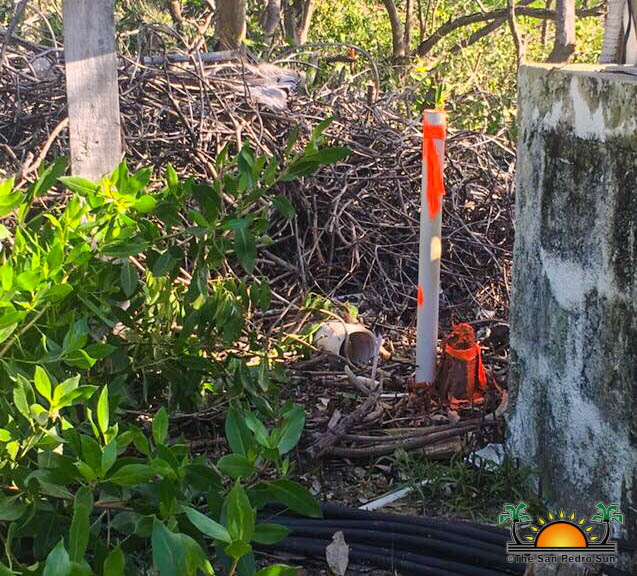
The majority of the cases of improper sewage disposal continue to be reported in the northern part of the island. In certain areas, concerned residents point out the daily leakage of raw sewage and black waters into the western coast of Ambergris Caye and septic tanks along leach beds built near the waterline. In some areas, pipes can be seen protruding from the ground through which the waste allegedly leaks into the environment. One resident, who prefers to stay anonymous, said that the situation continues to be undetected and has been ongoing for years. He claims that the waste from a local development, which apparently does not have a proper sewage system in their plans, continues to leak onto the western bayside of the island exposing people living nearby to diseases. The waste leaking onto the water is sometimes consumed by marine life, while some of it is carried away by the currents. The constant flow of waste can be carried by currents contaminating the waterways and affecting marine life as well.
One of the marine organisms most sensitive to this type of pollution is coral. Speaking with local sustainable development scientist Valentine Rosado, who heads his company called Grassroots Belize, corals are very vulnerable to this type of pollution and the threat it poses is immense. Rosado explained that any contaminants, in this case, raw sewage, that makes it to the bayside of the island can end up on the east coast of Ambergris Caye where the barrier reef is located. “The bay is like a transition area and it connects that whole area to the Caribbean Sea,” he said, adding that the major impacts could be visible in the longer run, after years of accumulated pollution. A call for better infrastructure in sewage treatment/disposal for northern Ambergris Caye is imperative before irreversible damages cripple the second largest reef system in the Western Hemisphere.
Sewage, a toxic dose for corals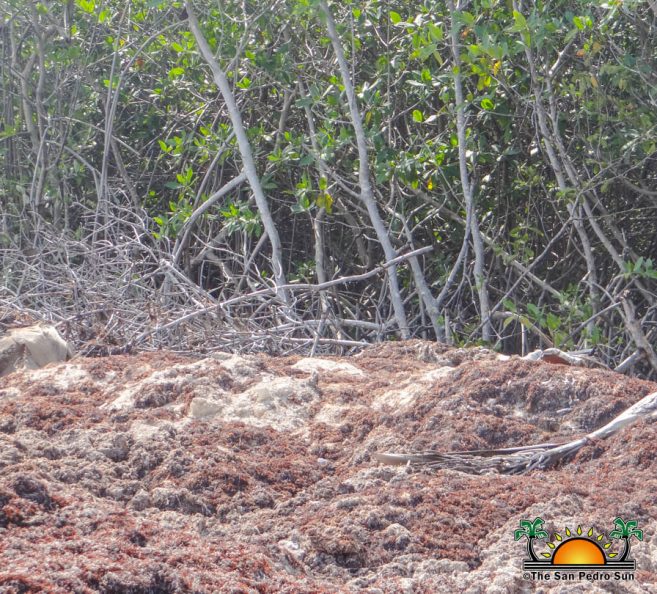
Raw sewage is not just human waste; it contains an excess of nutrients adding to the battle between the coral reef and seaweed for space and light. Kira Foreman, a marine biologist at the Hol Chan Marine Reserve adds that besides the overload of nutrients, sewage brings along with it a lot of other nasty things. “It is a toxic cocktail that can have a potentially fatal impact on corals,” said Foreman. “There are other pollutants within sewage, such as pharmaceuticals and all other drugs, like antibiotics that can end up in sewage affecting the health of the reef and the marine environment.” Another aspect of sewage is its primary component-fresh water. According to Foreman, this can stress and kill corals.
Foreman explained that sewage is full of bacteria and viruses, providing strength to pathogens on the coral’s surface, subjecting it to infections. She gave an example of a deadly outbreak of White pox disease in the mid- 1990s, which killed more than 70% of elkhorn corals in the Florida Keys in the United States of America. The disease has since spread to the Caribbean region where it continues to threaten this type of coral which plays a significant role in the structural and functional integrity of coral reef systems in the Atlantic area. Foreman indicated that the pathogen responsible for the White pox disease could be caused by a common intestinal bacterium found in humans and other animals. “The source from this disease perhaps comes from sewage,” said Foreman. Theories are that leakage of sewage from hospitals or commercial areas prompted the disease to appear and decimate sensitive natural resources such as the reef. “Lately, we have been monitoring the deadly Stony Coral Tissue Loss Disease, which allegedly originated in Florida and is killing corals. So far, there is no known treatment for it, and its origin is unknown but is believed to be caused by some pathogen,” indicated Foreman. If the cause is a pathogen related to humans, the origin is speculated to be a sewage leak into the waterways at some point. In the meantime, the disease has been detected at the Bacalar Chico Marine Reserve off the eastern coast of Ambergris Caye, threatening to move in a southward path.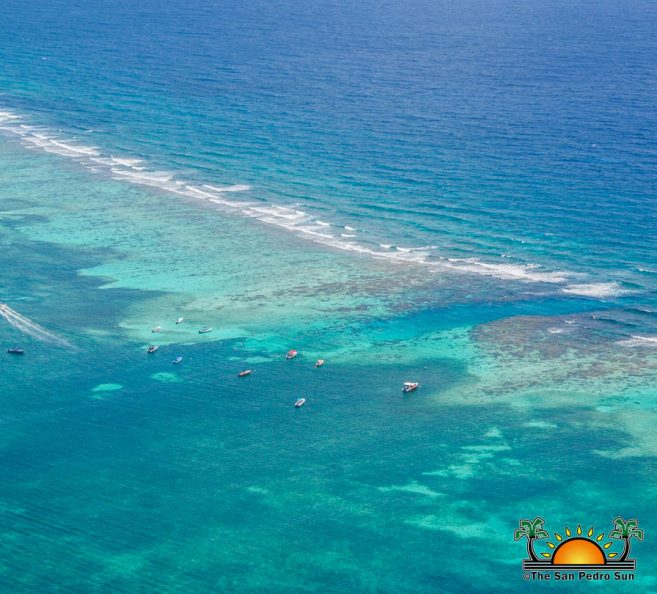
Additionally, the marine biologist pointed out that excess of sewage around the reef increases the sea temperature as a result of bacterial activity, leading to bleaching. Foreman stated that the improved sanitation and sewage treatment is very important, as it poses a great danger to the local marine ecosystem which supports thousands of livelihoods.
Local authorities aware of the problem
While a couple of reports made headlines in May 2015, when residents reported a local cargo operator dumping raw sewage onto the roadside leading to the dump area in southern Ambergris Caye, local authorities are still struggling with the issue. The solution to the problem at that time was the construction of a leaching bed for the disposal of the waste. A leaching bed is a number of individual absorption trenches laid parallel to one another. Each trench consists of a perforated PVC pipe surrounded by clean gravel. Filter cloth is laid on the top of the gravel to prevent fine particles in the backfill from clogging the spaces between the gravel. The raw sewage dumped onto the leaching bed flows down the perforated pipe and percolates through the gravel into the underlying soil for further decomposition. This method was spearheaded by the Belize Water Services Limited (BWSL) and was to be constructed beside the company’s sewage ponds on the southern part of the island. The attention then drifted north of San Pedro, when a year later, in October 2016, a popular beach resort was threatened with closure by the Department of Environment (DOE) for having improperly installed a sewer waste treatment system. With the intervention of the Area Representative Honorable Manuel Heredia Jr., the resort was given additional time to fix the problem or shut down. Today, the resort continues operating and it is unknown if they addressed the issue following DOE’s instructions. DOE was contacted to find out if the resort had complied with their demands, but no one could comment on it.
The issue once again raised eyebrows when in October 2017, dumping of raw sewage was reported north of town along a road leading to a popular beach area. Mayor Daniel Guerrero along with the police and members of the Health Department visited the area. It was obvious that sewage had been dumped beside the road, among the swampy mangrove area. Guerrero sent out a warning to the culprit(s) and asked the general public’s assistance in reporting such incidents by calling phone number 226-2198. No one could be held liable, but according to Guerrero, they believed the activity takes place under the cover of darkness and is perhaps a business establishment. The most recent reports on potential leakage of sewage have not been properly addressed by either the Health Department and DOE, and the only solution to put an end to this unhealthy situation is when the installation of a sewage treatment plant takes place in northern Ambergris Caye.
Current sewage treatment
Belize Water Services Limited counts with three gigantic sewage treatment ponds located south of San Pedro. Businesses and residences along the main street in downtown San Pedro and others along the southern part of town are the only ones on the island connected to the company’s sewage ponds. All other businesses and homes rely on septic systems. A representative of BWSL stated that before the sewage reaches their treatment ponds, it passes through seven underground stations and by the time it reaches the ponds the waste is almost dissolved. According to BWSL, their ponds use natural bacteria to break down the composition of human waste. Those not connected to their sewage system must hire cargo operators to clean their septic tank or use leeching fields that dissolve into the underwater systems of the island. Licensed operators on the island are Miguel Briceño, Julio Aguilar and Cesar Cerpa and they are responsible for taking the collected waste to BWSL ponds.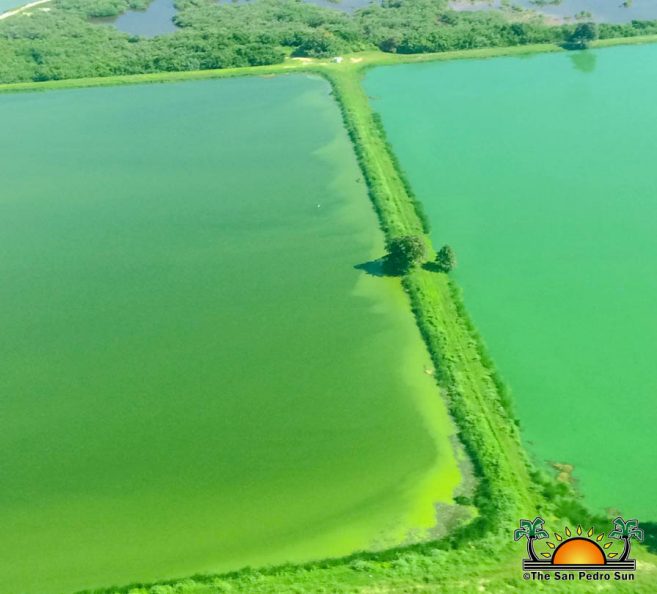
The company has indicated that their ponds are well secured and there is no possibility of leakage, although they are not far from the sea. However, in times of heavy rains, it is believed that the ponds overflow and some of its contents spill into the surrounding areas, including waterways. The area is surrounded by a dense forest of mangroves, which filters any toxins. According to biologist Keira Foreman at the Hol Chan Marine Reserve, with the increase of development in the area and the clearing of mangroves, such filtration may decrease and increase the chances of contamination. The clearing of mangroves on the island for development is not only perceived as a negative impact on the natural ecosystem, but it also threatens the habitat of native wildlife such as crocodiles, who are beginning to be affected with the boom in the construction sector on the island.
Plans for Northern Ambergris Caye
In the meantime, The San Pedro Town Council (SPTC) has mandated every business establishment on the north-west coast of the island, particularly at an area known as Secret Beach to build aerated septic tanks. This initiative is to promote the proper treatment of sewage and other waste matters to protect the sensitive local environment. SPTC has stated that liquor licenses will not be renewed for noncompliant businesses in that area. It is yet to be seen if this initiative will be enforced.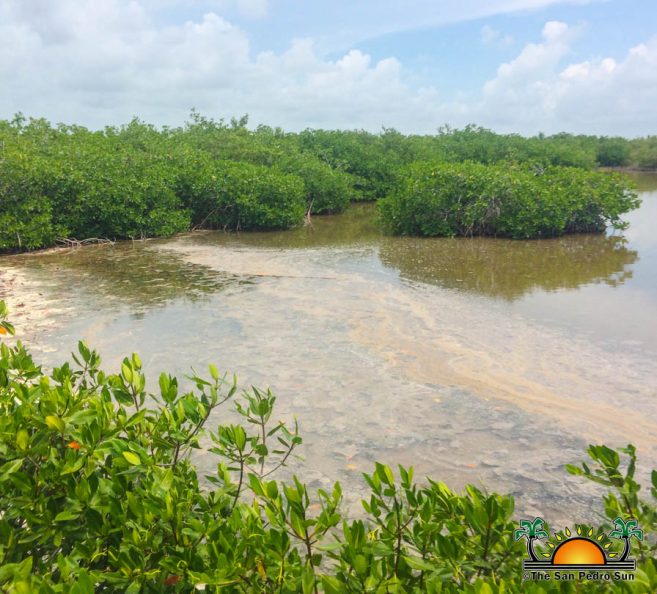
On the other hand, Area Representative Heredia Jr. stated that he is aware that improper sewage disposal continues and is working on getting more infrastructure for the northern part of the island. “In the northern part of San Pedro, we are working on a loan for the expansion of water and sewer system,” he said. Heredia added that Central Government is working along with BWSL hoping to soon start this important project which has been on hold for quite some time due to lack of funding. However, BWSL is confident that in 2020 they will start the construction of the said plant, some 12 miles north of downtown San Pedro to the tune of $BZ60 million. The plant will not only treat raw waste but also count with a reverse osmosis desalination water treatment plant. However, there have been no further announcements if the funds have been secured, and until then the health of the local environment and the great Meso-American Barrier Reef System continues to be exposed to contaminates, running the risk of someday returning to UNESCO’s list of endangered World Heritage Sites, after it was removed in June of 2018.
Other alternatives to help the reef
To replenish areas along the barrier reef where corals have died, the San Pedro Tour Operators Association (SPTOA) has embarked on a reef rehabilitation project. This initiative involves the Kids in Action Club, which certifies young divers every year. The program exposes children and adults alike to the marine environment and engages them in sustainable projects. Currently, nurseries consisting of frames have been built and placed under the sea on the eastern side of the island, with hundreds of coral fragments attached to it. When they are mature, these corals will be transplanted to designated areas along the barrier reef.
According to Everette Anderson, Chairman of the SPTOA, the project, focuses on three types of coral to be rehabilitated. These are the Elk Horn, Stalk Horn, and Fused Corals. Anderson stated that these corals grow fast, thus, they expect to relocate the new corals from the nurseries in a short period of time. He has noted some challenges due to the rise in water temperatures, but the outcome is looking well. “Our nursery has recovered from this year’s bleaching, and now we need to expand it, care for it if we want to make a difference,” said Anderson. He noted that every two weeks they visit the nurseries to remove any algae that could affect the growth of the corals. As a tour operator, he sees the importance of the reef system and believes that it is everyone’s responsibility to take care of it in any way possible. The reef rehabilitation project shines a light of hope in the daily battle for the preservation of this highly valuable natural resource and has the full support of the Fisheries Department and the Ministry of Environment.
What can you do?
It is recommended that your septic is compliant with the Health Department’s regulations, particularly if you are required to install an aerated system. Also, ensure that whenever you hire someone to empty your system, a receipt from the BWS water treatment plant is provided. Furthermore, report suspicious dumping or leaking pipes to the relevant authorities like The San Pedro Town Council at 226-2198.
‘This story was produced with support from Internews’ Earth Journalism Network.’

